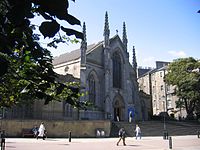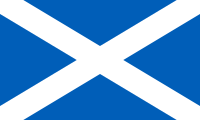
Back الرومانية الكاثوليكية في إسكتلندا Arabic Römisch-katholische Kirche in Schottland German Katolinen kirkko Skotlannissa Finnish Église catholique en Écosse French Gereja Katolik di Skotlandia ID スコットランドのカトリック Japanese 스코틀랜드의 로마 가톨릭교회 Korean Den katolske kirke i Skottland NB Kościół katolicki w Szkocji Polish Igreja Católica na Escócia Portuguese
Catholic Church in Scotland | |
|---|---|
| Scottish Gaelic: An Eaglais Chaitligeach ann an Alba | |
 Crucifixion of Saint Andrew, by Juan Correa de Vivar (1540–1545) | |
| Classification | Catholic |
| Orientation | Latin |
| Scripture | Bible |
| Theology | Catholic theology |
| Polity | Episcopal |
| Governance | BCOS |
| Pope | Francis |
| President | Hugh Gilbert |
| Apostolic Nuncio | Miguel Maury Buendía |
| Region | Scotland |
| Language | English, Latin |
| Founder | Saint Ninian, Saint Mungo, Saint Columba |
| Origin | c. 200s: Christianity in Roman Britain c. 400s: Medieval Christianity |
| Separations | Church of Scotland |
| Members | 841,053 (2011)[1] |
| Official website | bcos.org.uk |
| Part of a series on the |
| Catholic Church by country |
|---|
 |
|
|

The Catholic Church in Scotland (Scottish Gaelic: An Eaglais Chaitligeach ann an Alba; Scots: Catholic Kirk in Scotland) overseen by the Scottish Bishops' Conference, is part of the worldwide Catholic Church headed by the Pope. After being firmly established in Scotland for nearly a millennium, the Catholic Church was outlawed following the Scottish Reformation in 1560. Throughout the centuries of religious persecution changes, several pockets in Scotland retained a significant pre-Reformation Catholic population, including Banffshire, the Hebrides, and more northern parts of the Highlands, Galloway at Terregles House, Munches House, Kirkconnell House, New Abbey and Parton House and at Traquair in Peebleshire.
In 1716, Scalan seminary was established in the Highlands and rebuilt in the 1760s by Bishop John Geddes, a well-known figure in Edinburgh during the Scottish Enlightenment. When Scottish national poet Robert Burns, who also gifted the Bishop with the volume now known as The Geddes Burns, wrote to a correspondent that "the first [that is, finest] cleric character I ever saw was a Roman Catholick", he was referring to Bishop John Geddes.[2]
Catholic emancipation in 1793 and 1829 helped Catholics regain both religious and civil rights. In 1878, the Catholic hierarchy was formally restored.[3]
Many Scottish Roman Catholics are the descendants of Irish immigrants and of Scottish Gaelic-speaking migrants from the Highlands and Islands who both moved into Scotland's cities and industrial towns during the 19th century, especially during the Highland Clearances, the Highland Potato Famine, and the similar famine in Ireland. However, there are also significant numbers of people of Italian, Lithuanian,[4] and Polish descent, with more recent immigrants again boosting the numbers of continental Catholics of Eastern European descent in Scotland. Owing to immigration (overwhelmingly white European), it is estimated that, in 2009, there were about 850,000 Catholics in a country of 5.1 million.[5]
The Gàidhealtachd has been both Catholic and Protestant in modern times. A number of Scottish Gaelic-speaking areas, including Barra, Benbecula, South Uist, Eriskay, and Moidart, are mainly Catholic. (See also the "Religion of the Yellow Stick".)
Similarly to iconic Pre-Reformation Scottish poets and writers like Aneirin, Blind Harry, Walter Kennedy, and William Dunbar, many of the most important figures in Scottish Gaelic literature have been Catholics who have written frequently about their Catholic Faith in their work. Their numbers have included Scottish Gaelic national poet Alasdair mac Mhaighstir Alasdair, Fr. Allan MacDonald, Allan The Ridge MacDonald, Iain Lom, Dòmhnall Iain Dhonnchaidh, Sìleas na Ceapaich, and Angus Peter Campbell. Furthermore, Scottish nationalist and literary scholar John Lorne Campbell and his wife, American ethnomusicologist Margaret Fay Shaw, who together helped lay the foundation for the modern Scottish Gaelic language revival, were both converts from Protestantism to Catholicism.
In the 2011 census, 16% of the population of Scotland described themselves as being Catholic, compared with 32% affiliated with the Church of Scotland.[6] Between 1994 and 2002, Catholic attendance in Scotland declined 19% to just over 200,000.[7] By 2008, the Catholic Bishops' Conference of Scotland estimated that 184,283 attended Mass regularly.[8]
- ^ "Scotland's Census 2011 – Table KS209SCb"
- ^ Michael Martin, "Sae let the Lord be thankit," The Tablet, 27 June 2009, 20.
- ^ Archdiocese of Edinburgh Archived 6 August 2018 at the Wayback Machine www.archdiocese-edinburgh.com. Retrieved 21 February 2009
- ^ "Immigration and Emigration – Scotland – Strathclyde – Lithuanians in Lanarkshire". BBC. Retrieved 18 December 2011.
- ^ Andrew Collier "Scotland's confident Catholics" Tablet 10 January 2009, pg. 16
- ^ "Census reveals huge rise in number of non-religious Scots (From Herald Scotland)". Heraldscotland.com. 27 September 2013. Retrieved 17 December 2015.
- ^ Tad Turski (1 February 2011). "Statistics". Dioceseofaberdeen.org. Archived from the original on 29 November 2011. Retrieved 18 December 2011.
- ^ "How many Catholics are there in Britain?". BBC News. 15 September 2010. Retrieved 6 March 2013.
© MMXXIII Rich X Search. We shall prevail. All rights reserved. Rich X Search
